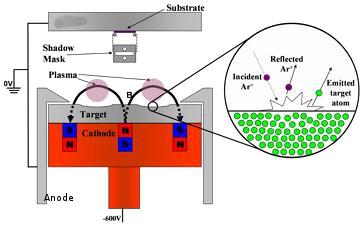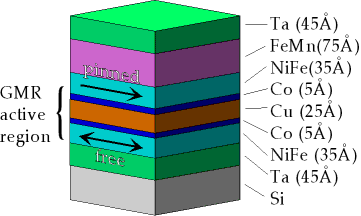Sputtering
The term sputtering refers to the removal of material from a target by the impacts of high energy particles. The ejected atoms then build up on any surface they land on, leading to the deposition of a thin film of the target material. The technique was first discovered in the 1850’s, but with the advent of modern vacuum technology it is now possible to deposit films of extremely high quality.
The sputter deposition systems in the CM group here at Leeds use a technique called magnetron sputtering, illustrated in the figure below.

An electric field is applied between the target and the substrate, and a small amount of argon gas is introduced to the deposition chamber. The electric field acts to ionise the neutral argon atoms, causing them to accelerate toward the negatively charged target. The resulting collision leads to the ejection of atoms and electrons from the target. Some of the ejected atoms land on the substrate, and a layer of material begins to build up. The emitted electrons are confined close to the surface by a magnetic field generated by an array of magnets beneath the target. This confinement increases the ionisation rate of argon atoms and therefore increases the sputter rate, which is defined as the thickness of material deposited on the substrate per second.
Using several different magnetron sources, and a carousel to move the substrate between the sources, it is possible to deposit structures consisting of several different layers of materials. The figure below shows the layers that comprise a typical spin valve structure.

For more information on the sputter deposition systems available in the CM group, please click here.
